
20 Amazing Aquarium Carpet Plants You Should Try

Writer at The Aquarium Keeper
Carpeting aquarium plants are really popular amongst many fishkeepers, simply because it is a great addition to almost any aquarium. Although a lot of people have a hard time growing aquarium carpet plants in their aquariums, it is relatively easy, and there are a lot of plants, that are suitable for beginner fish keepers. On the other hand, there are also more delicate plants, that only more experienced people can grow. Continue reading, and pick the best plant for you!
What Are Ground Cover Aquarium Plants?
Ground cover or aquarium carpet plants are mainly used in the foreground section of the aquarium, and really don’t grow that large in terms of height. These plants spread across the whole substrate, creating a green lush look, that resembles a carpet. Some plants propagate by creating smaller plants in the substrate, while others can be trimmed down and replanted again.
Another reason why ground cover plants are essential in every tank is that they can provide hiding places for smaller fish. Shrimp especially love carpeting plants, even though there are a lot of other suitable plants for shrimp. Smaller creatures can use these plants as protection, while other larger fish can see carpeting plants as a soft and safe place to spawn their offspring.
Why Are Some Carpet Plants Easier to Take Care of Than Others?
Every aquatic plant is different, and some are more delicate than others. Aquarium carpet plants especially are less hardy than most popular plants (anubias, bucephalandra), because they require more nutrients and light to survive. These plants are very close to the substrate, which means they get less light and have a harder time growing.
Nevertheless, there are some tough carpet plants that can even grow in low-tech aquarium setups. The reason why some aquarium carpet plants are more durable than others is because of their natural habitat. Some plants are just more adapted to worse environments than others.
What Does Every Aquarium Carpeting Plant Need?
To grow a carpet aquarium plant successfully, there needs to be enough nutrients and light in the aquarium. Some plants are less needy than others, but all of them need nutrients and lightning, some even need extra CO2 injections. Before getting any carpet aquarium plant, make sure you have at least an aquarium plant light, and nutrient-rich substrate.
Best Carpeting Plants For Your Aquarium
There are a lot of aquarium ground cover plants in the hobby, but this list features the most popular and available plants.

As the title of the article mentions, I will cover the most easiest plants first, then get to the needy plants, that only more experienced fishkeepers could keep.
Dwarf Hairgrass "Eleocharis parvula"
Dwarf hairgrass takes the list as one of the easiest aquarium carpet plants to grow. It is literally the same as any grass outside, just for water and aquariums. Another thing is that dwarf hairgrass can create a dense carpet, that can provide a lot of protection for smaller aquatic creatures, such as shrimp and baby fish.
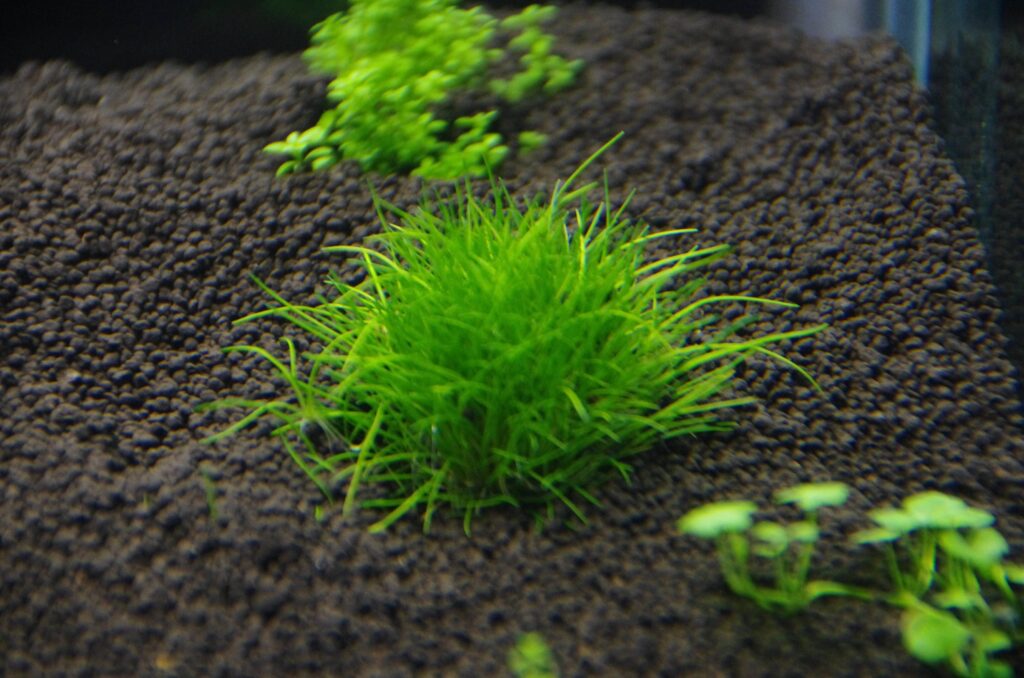
| Aspect | Information |
|---|---|
| Scientific Name | Eleocharis parvula |
| Origin | North America, Europe, Asia |
| Water Temperature | 22–26 °C (72-79 °F) |
| Growth Rate | Fast |
| Light Intensity | Medium |
| pH | 6.5 - 7.5 |
| Need for CO2 | Does not need CO2, but improves growth rate and coloration |
| Maximum Height | 7 inches |
| Care Level | Easy |
CO2 is not necessary for this plant, although it could possibly increase the growth and give it a more beautiful color. This particulr plant propagates by shooting out runners (small new plants near the main plant), and that can eventually turn into a beautiful carpet.
It is also important, that you plant dwarf hairgrass correctly. The most beginner mistake you can make is to plant a big clump of dwarf hairgrass in the same spot. By doing this, some parts of the plants will have a harder time rooting, and will eventually be uprooted by other pieces of dwarf hairgrass. By sticking small clumps of dwarf hairgrass into the substrate, you will force the plant to search for extra nutrients, which will result in more aggressive propagation.
Hydrocotyle Tripatita
Moving on, another aquarium carpeting plant is the hydrocotyle tripatita. It easily carpets into all directions, and is widely accessible everywhere.

| Aspect | Information |
|---|---|
| Scientific Name | Hydrocotyle Tripatita |
| Origin | Australia, New Zealand |
| Water Temperature | 22–28 °C (72–82 °F) |
| Growth Rate | Fast |
| Light Intensity | Medium |
| pH | 6.0 - 7.5 |
| Need for CO2 | Doesn't require additional CO2, but enhances coloration and growth |
| Maximum Height | 5 inches |
| Care Level | Easy |
Hydrocotyle tripatita resembles the clover plant in appearance, which can be found in nature. This particular plant is very hardy, and can easily adapt to a bunch of different environments. Another cool fact about this plant is that you can grow it submerged (underwater), and emersed (partially in water). Because of this cool characteristic, hydrocotyle tripatita is also used widely in paludariums.
At first, it can be slightly challenging with hydrocotyle tripatita. This plant can be planted by simply sticking it into the substrate. Planting is the easy part, but making it grow horizontally instead of vertically is harder. You will need to occasionally trim hydrocotyle tripatita, because by default it will usually start growing vertically when planted. By doing this repeatedly, hydrocotyle tripatita will start to grow horizontally, which will result in a beautiful carpet for your aquarium.
Java Moss "Vesicularia dubyana"
Java moss is probably the most popular plant on this list. It is a column feeding aquarium plant, that is widely used in low-tech setups since it is widely durable and can tolerate a wide range of different water parameters. Many fishkeepers attach java moss to rocks, driftwood, and other decorations.

| Aspect | Information |
|---|---|
| Scientific Name | Vesicularia dubyana |
| Origin | Asia |
| Water Temperature | 15–27 °C (60–80 °F) |
| Growth Rate | Slow |
| Light Intensity | Low to medium |
| pH | 5.0 - 8.0 |
| Need for CO2 | Does not need CO2, but improves growth rate and coloration |
| Maximum Height | 4 inches |
| Care Level | Easy |
Another important thing is that you can’t bury java moss in the substrate, because it will eventually die and rot. If you want java moss to carpet the bottom part of your tank, try using mesh plates and tangle the moss into the plates. Place the plates onto the substrate, and eventually, your java moss will spread across the bottom of the tank.
Christmas Moss "Vesicularia montagnei"
Another easy plant that can create a beautiful carpet is christmas moss. It is very similar to java moss, although likes slightly different water temperatures and pH. Both plants are very alike, and sometimes it can be even hard to tell them apart. Everything that is said about java moss can also be applied to christmas moss.

| Aspect | Information |
|---|---|
| Scientific Name | Vesicularia montagnei |
| Origin | Asia |
| Water Temperature | 15–30°C (59–86 °F) |
| Growth Rate | Slow |
| Light Intensity | Low to medium |
| pH | 5.0 - 7.5 |
| Need for CO2 | Does not need CO2, but improves growth rate and coloration |
| Maximum Height | 4 inches |
| Care Level | Easy |
This plant is also best used with mesh plates. You can easily build a carpet or even a moss wall with christmas moss. Similar to java moss, this particular plant also grows slowly, but introducing CO2 injections can speed things up, and even give the plant brighter colors.
Dwarf Sagittaria "Sagittaria subulata"
Another relatively easy beginner plant is dwarf sagittaria. This plant resembles basic grass, that can be found outside. Similar to hydrocotyle tripatita, it can also grow fully submerged and emersed, which just proves how durable this aquatic plant is.

| Aspect | Information |
|---|---|
| Scientific Name | Sagittaria Subulata |
| Origin | South America |
| Water Temperature | 22–28 °C (72–82 °F) |
| Growth Rate | Fast |
| Light Intensity | Medium |
| pH | 6.0 - 8.0 |
| Need for CO2 | Does not need CO2, but improves growth rate and coloration |
| Maximum Height | 7 inches |
| Care Level | Easy |
Crystalwort "Riccia fluitans"
Riccia Fluitans or crystalwort is very similar to java moss in terms of characteristics. This plant is highly versatile and can be used in both low and high-tech setups. In the wild, riccia fluitans mainly is found floating, but they can also be attached to things like rocks and driftwood.
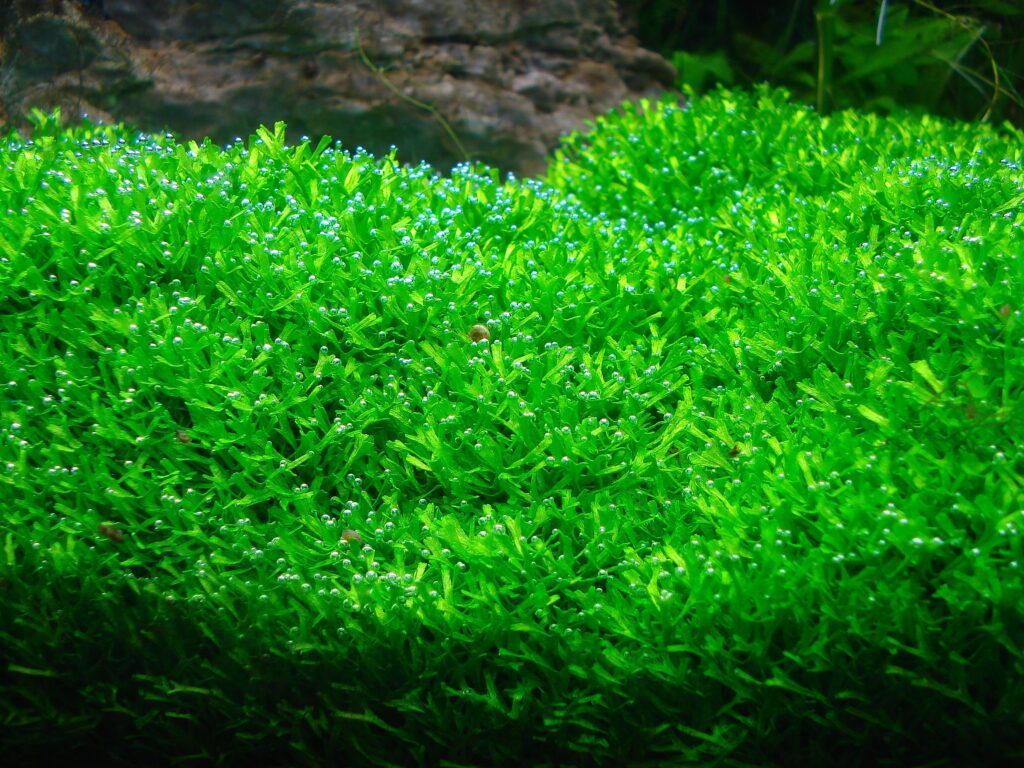
| Aspect | Information |
|---|---|
| Scientific Name | Riccia fluitans |
| Origin | North America, Eurasia |
| Water Temperature | 20–26 °C (68–79 °F) |
| Growth Rate | Fast |
| Light Intensity | Medium to high |
| pH | 6.0 - 8.0 |
| Need for CO2 | Does not need CO2, but helps with coloration and growth rate |
| Maximum Height | 1.5 inches |
| Care Level | Easy |
Utricularia graminifolia
Another great plant is utricularia graminifolia. This particular plant is light green, even yellowish, which is a great switch up from the basic green color. Some might argue, that this plant is relatively hard to keep, but that is not the case if you do things the right way.

| Aspect | Information |
|---|---|
| Scientific Name | Utricularia graminifolia |
| Origin | Asia |
| Water Temperature | 18–25 °C (65–77 °F) |
| Growth Rate | Medium |
| Light Intensity | Medium to high |
| pH | 5.0 - 6.5 |
| Need for CO2 | Does not need additional CO2 injections, but helps with growth rate and coloration |
| Maximum Height | 15 inches |
| Care Level | Easy |
Another cool fact about utricularia graminifolia is that it will grow shorter, if the light is stronger, and will grow longer if the light is not that strong. Plants enjoy light, and if more light is needed, they will make the effort to get closer to it.
Shoreweed "Littorella uniflora"
Moving on, another interesting aquarium carpeting plant is the shoreweed. It is a grass-type carpeting plant, that is very suited for beginner plant keepers.

| Aspect | Information |
|---|---|
| Scientific Name | Littorella uniflora |
| Origin | Europe |
| Water Temperature | 20–26 °C (68–79 °F) |
| Growth Rate | Slow |
| Light Intensity | Medium |
| pH | 6.0 - 7.0 |
| Need for CO2 | Does not need additional CO2 injections, but helps with growth rate and coloration |
| Maximum Height | 2 inches |
| Care Level | Easy |
Although shoreweed is very forgivable and can live in a bunch of different conditions. This plant enjoys moderate lightning, and also propagates through runners.
Dwarf Four Leaf Clover "Marsilea hirsuta"
Moving on, the dwarf four leaf clover is very loved by the fishkeeping community. The unique-looking leaves are one of the best characteristics of this plant. Although marsilea hirsuta grows slower than other carpet plants, it is hardy and can sustain environmental changes.

| Aspect | Information |
|---|---|
| Scientific Name | Marsilea hirsuta |
| Origin | Australia |
| Water Temperature | 20–25 °C (68–77 °F) |
| Growth Rate | Slow |
| Light Intensity | Medium to high |
| pH | 6.0 - 7.5 |
| Need for CO2 | Does not need additional CO2 injections, but helps with growth rate and coloration |
| Maximum Height | 5 inches |
| Care Level | Easy |
Staurogyne Repens
If you like larger leaves, and more bush-type carpets, then staurogyne repens is right for you. This particular plant will create a carpet, that is taller and lusher. Staurogyne repens is a very hardy, slow-growing plant.

| Aspect | Information |
|---|---|
| Scientific Name | Staurogyne Repens |
| Origin | Brazil, Guyana |
| Water Temperature | 20–30 °C (68–86 °F) |
| Growth Rate | Slow |
| Light Intensity | Medium to high |
| pH | 6.0 - 8.0 |
| Need for CO2 | Does not need additional CO2 injections, but helps with growth rate and coloration |
| Maximum Height | 5 inches |
| Care Level | Easy |
Monte Carlo "Micranthemum tweediei"
Moving on, mote carlo is one of the most popular aquarium carpeting plants, since it is beginner friendly, and can do well in larger or smaller setups.
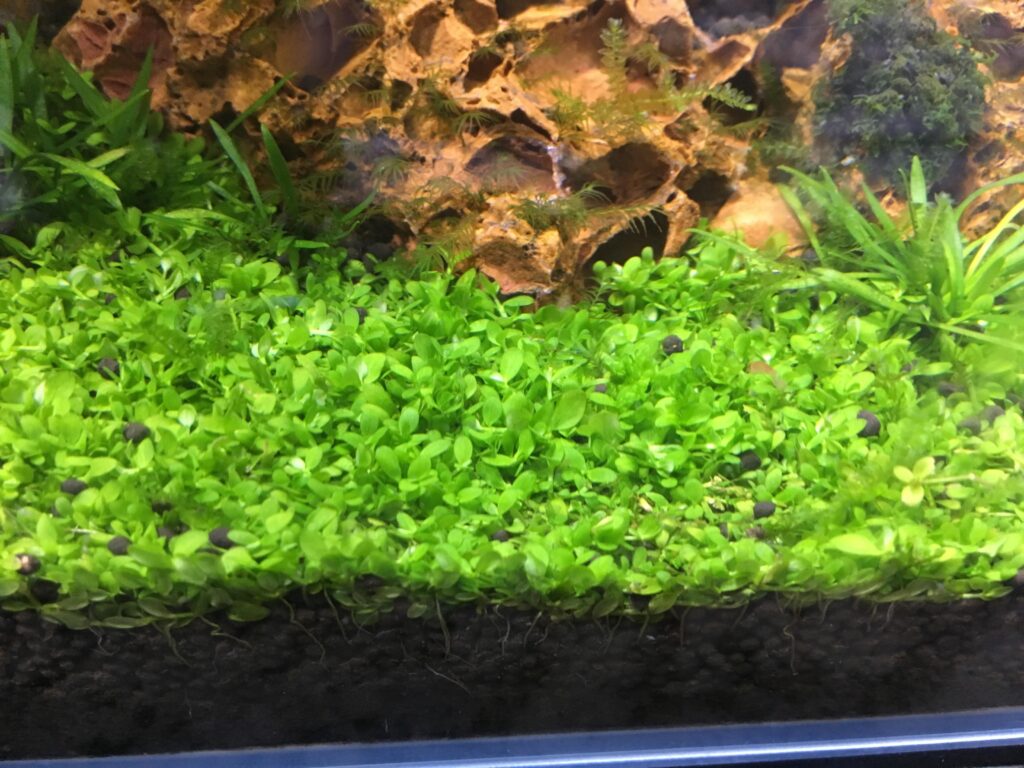
| Aspect | Information |
|---|---|
| Scientific Name | Micranthemum tweediei |
| Origin | Eastern USA |
| Water Temperature | 20–25 °C (68–75 °F) |
| Growth Rate | Fast |
| Light Intensity | Medium |
| pH | 6.0 - 7.5 |
| Need for CO2 | Does not need it but will grow faster with CO2 |
| Maximum Height | 1.25 inches |
| Care Level | Easy |
Planting and propagating this plant is very easy.
Monte carlo can be easily planted using tweezers, and then propagated, by cutting the new growth on top of the plant, and replanting it again. Don’t forget, that this plant is considered a “runner”, which means it will automatically create new plants, that will eventually pop out of your substrate.
Cryptocoryne Parva
Crypt plants are very known in the aquarium hobby, and cryptocoryne parva is one of the smallest plants out of the family genus. If you like long and bigger leaves, this plant might be the best one for your aquarium carpet.

| Aspect | Information |
|---|---|
| Scientific Name | Cryptocoryne Parva |
| Origin | Sri Lanka |
| Water Temperature | 20–28 °C (68–82 °F) |
| Growth Rate | Slow |
| Light Intensity | Low to medium |
| pH | 5.5 - 7.5 |
| Need for CO2 | Does not need additional CO2 injections, but helps with growth rate and coloration |
| Maximum Height | 4 inches |
| Care Level | Medium |
Pygmy Chain Sword "Echinodorus tenellus"
Moving on, the pygmy chain sword aquarium carpet plant is an excellent species for slightly more experienced plant keepers. It is bright green in color and can look like small vallisneria species.

| Aspect | Information |
|---|---|
| Scientific Name | Echinodorus tenellus |
| Origin | West Indies, Central America, South America |
| Water Temperature | 22–26 °C (72–80 °F) |
| Growth Rate | Fast |
| Light Intensity | Medium to high |
| pH | 6.5 - 7.5 |
| Need for CO2 | Does not need additional CO2 injections, but helps with growth rate and coloration |
| Maximum Height | 4.5 inches |
| Care Level | Medium |
Pygmy chain sword or echinodorus tenellus is another grass-looking plant, that can be ideal for aquarium carpets. It is not a very picky plant, but to grow pygmy chain sword successfully, more advanced light will be needed. It is not as popular as other grass-like plants (dwarf hairgrass or dwarf sagittaria).
Another simple thing about this plant is its propagation. Pygmy chain sword simply propagates through runners, but it needs moderate light and enough nutrients to fully thrive.
Blyxa Japonica
Moving on, blyxa japonica is a good carpet plant, if you like a carpet that is bigger in terms of height. This plant is heavily reliant on the substrate because blyxa japonica is considered a root feeder. To successfully grow this plant, you would need a nutrient-rich substrate.
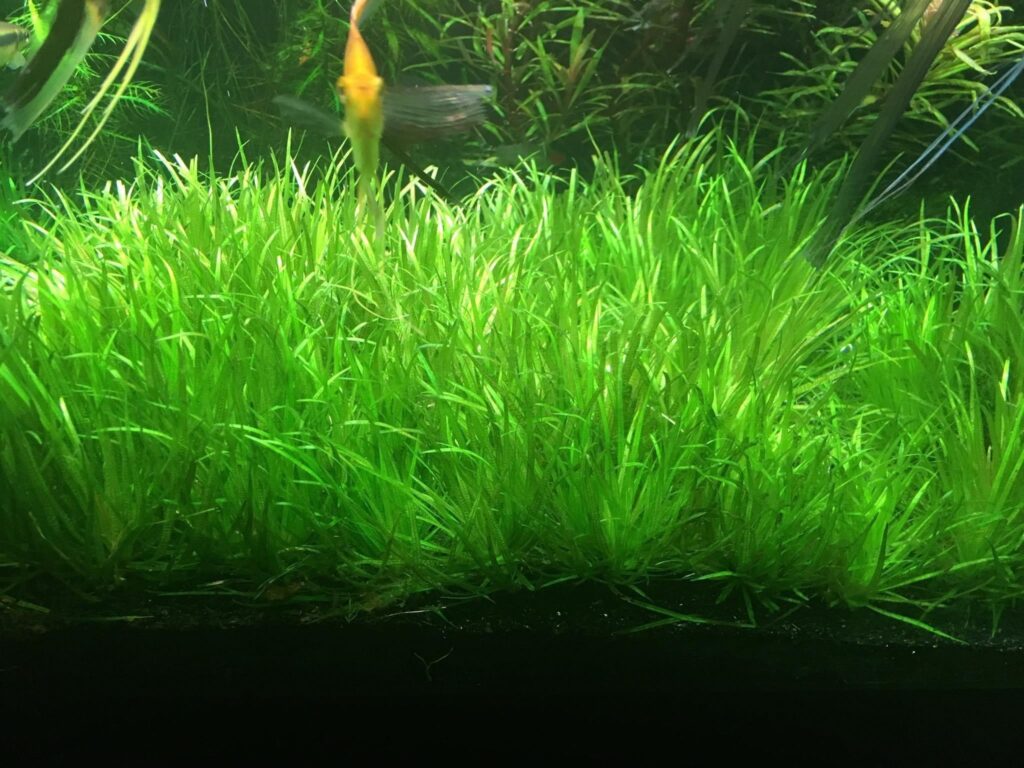
| Aspect | Information |
|---|---|
| Scientific Name | Blyxa Japonica |
| Origin | Asia |
| Water Temperature | 21–27 °C (70–81 °F) |
| Growth Rate | Medium |
| Light Intensity | Medium to high |
| pH | 5.5 - 7.0 |
| Need for CO2 | Does not require additional CO2, but helps with plant coloration and growth rate |
| Maximum Height | 9 inches |
| Care Level | Medium |
Brazilian Micro Sword "Lilaeopsis brasiliensis "
A plant that has a similar appearance to blyxa japonica is the brazilian micro sword. This plant is slightly harder than others, simply because it grows very slowly, although it is quite tough and forgiving.

| Aspect | Information |
|---|---|
| Scientific Name | Lilaeopsis brasiliensis |
| Origin | South America |
| Water Temperature | 22–29 °C (72–85 °F) |
| Growth Rate | Slow |
| Light Intensity | Medium to high |
| pH | 5.0 - 7.5 |
| Need for CO2 | Does not require CO2 injections, but can improve growth rate and coloration. Carpet might become sparse without CO2 |
| Maximum Height | 4 inches |
| Care Level | Medium |
Dwarf Baby Tears "Hemianthus callitrichoides"
One of the harder plants on this list is called dwarf baby tears. In terms of appearance, this plant looks different from all the grass-looking plants, and a fully-grown carpet can be a pleasant view. There are a few reasons why this plant is challenging.

| Aspect | Information |
|---|---|
| Scientific Name | Hemianthus callitrichoides |
| Origin | West Indies |
| Water Temperature | 20–24 °C (68–75 °F) |
| Growth Rate | Slow |
| Light Intensity | Medium to high |
| pH | 6.0 - 7.5 |
| Need for CO2 | CO2 is recommended, but it would grow without it too |
| Maximum Height | 1.25 inches |
| Care Level | Medium to high |
Thirdly, dwarf baby tears can only be propagated by cutting off the top part and replanting it back into the substrate. This can cause more uprooting problems since the new plants will not have roots developed yet.
Glosso "Glossostigma elatinoides "
Another plant for more experienced people is glossostigma elatinoides. This plant has amazing leaves, that are round and not long.

| Aspect | Information |
|---|---|
| Scientific Name | Glossostigma elatinoides |
| Origin | Australia, New Zealand |
| Water Temperature | 22–28 °C (72–82 °F) |
| Growth Rate | Fast |
| Light Intensity | Medium to high |
| pH | 6.0 - 7.0 |
| Need for CO2 | Very hard to grow without additional CO2 |
| Maximum Height | 1.5 inches |
| Care Level | Hard |
One positive thing about glossostigma elatinoides is the method of propogation. This plant reproduces using runners, which means there is atleast one simple thing about glosso, that would make maintenance easier.
Elatine Hydropiper
One of the most elegant and smallest aquatic plants is elatine hydropiper. This particular plant requires a lot of nutrients, strong light, and extra CO2 injections to grow and thrive.
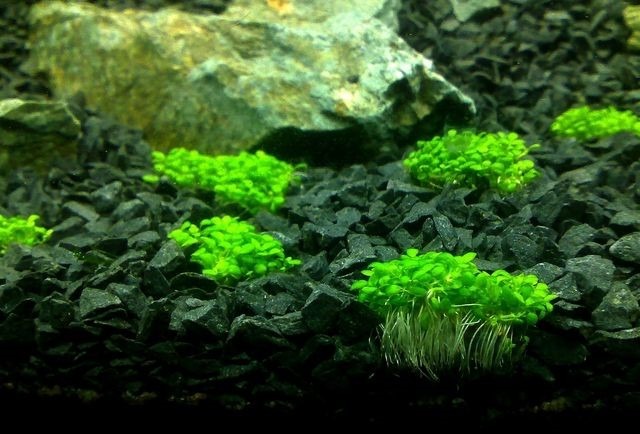
| Aspect | Information |
|---|---|
| Scientific Name | Elatine Hydropiper |
| Origin | Europe |
| Water Temperature | 20–26 °C (68–79 °F) |
| Growth Rate | Medium |
| Light Intensity | Medium to high |
| pH | 5.0 - 8.0 |
| Need for CO2 | Very hard to grow without additional CO2 |
| Maximum Height | 2 inches |
| Care Level | Hard |
Propagation is fairly simple. Elatine hydropiper multiplies using runner plants. It can be very hard for beginners to take care of this plant since it requires a high-tech tank, and experience, which can only be achieved through time.
Little Star "Pogostemon helferi"
Moving on, one of the hardest carpet aquarium plants and one of the most unique-looking is pogostemon helferi. It is also called “little star”, simply because of the plant looks, which literally resembles a star. The appearance sometimes can fool a beginner into buying the plant, which usually results in the plant slowly dying off.
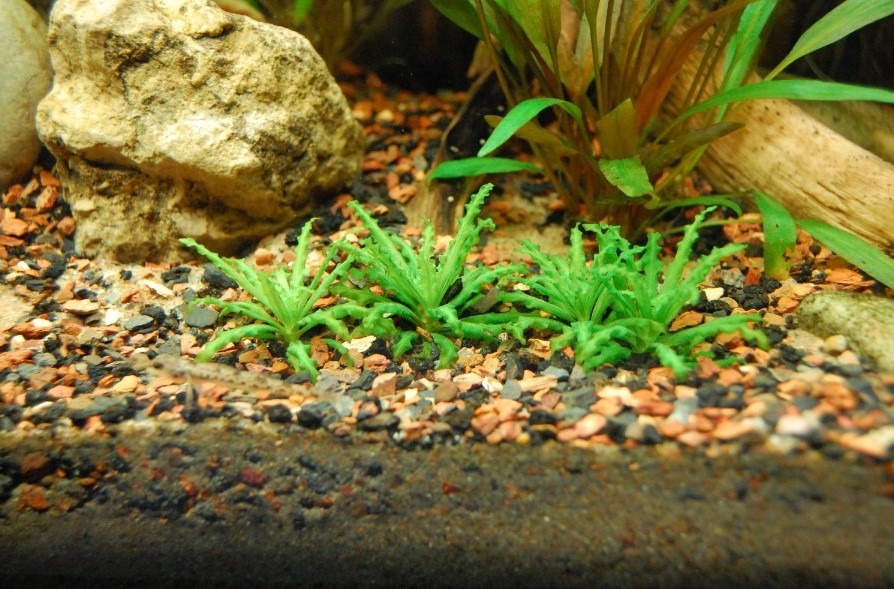
| Aspect | Information |
|---|---|
| Scientific Name | Pogostemon helferi |
| Origin | Asia, Africa, Australia |
| Water Temperature | 22–26 °C (72–80 °F) |
| Growth Rate | Slow |
| Light Intensity | Medium to high |
| pH | 6.0 - 8.0 |
| Need for CO2 | Very hard to grow without additional CO2 |
| Maximum Height | 7 inches |
| Care Level | Very hard |
Giant Baby Tears "Micranthemum umbrosum"
The very last plant on this list is micranthemum umbrosum or giant baby tears. It is one of the hardest aquarium carpet plants in this hobby.

| Aspect | Information |
|---|---|
| Scientific Name | Micranthemum umbrosum |
| Origin | Eastern USA |
| Water Temperature | 20–24 °C (68–75 °F) |
| Growth Rate | Slow |
| Light Intensity | Medium to high |
| pH | 6.0 - 7.5 |
| Need for CO2 | Very hard to grow without additional CO2 |
| Maximum Height | 2 inches |
| Care Level | Very Hard |
Frequently Asked Questions
Why Are my Aquarium Plants Dying?
There can be a lot of reasons why your aquarium plants are dying, but the most popular ones are melting, nutrient deficiency, too much lightning, and bad water parameters. Check your water condition, and makes sure your plants have enough nutrients. Another thing that you should do is figure out your plant-specific requirements so that you can adjust your aquarium environment to the plant’s needs.
Can Dwarf Hairgrass Grow in Gravel?
It can definitely grow in gravel, but you would need root tabs to supply nutrients to your plants. The better option would be to get a nutrient-rich substrate. By doing this, your dwarf hairgrass would have an easier time thriving and creating a beautiful carpet.
Writer's Thoughts
The aquarium carpet plant is essential, because it is beautiful, and can help your small fish and shrimp. Although some plants are tricky, most aquarium carpet plants are relatively beginner friendly, so pick one that suits you and create an amazing carpet!
If you enjoyed reading our article about aquarium carpet plants, please feel free to share it with your friends by clicking the social media buttons below:





